Innovation
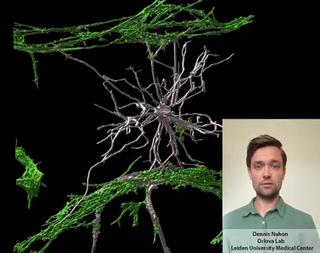
Innovation examples
Innovation
Stem cell derived Vessels-on-Chip to study brain disorders
Dennis Nahon is a PhD candidate in the Department of Anatomy and Embryology at the Leiden University Medical Center. In his research, under supervision of Dr. Valeria Orlova (https://www.orlovalab.com/) and Prof. Dr. Christine Mummery, he aims to mimic a blood vessel in the brain by combining different stem cell derived cell types, in a 3D Vessel-on-Chip model. Here, an example of these in vitro blood vessels is shown in which certain brain cells known as astrocytes (in white) interact with the blood vessels (in red). This model paves the way for investigating brain vessels outside the human body, while reducing the need for animal models.
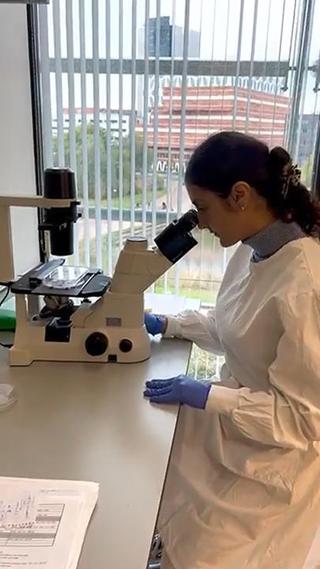
Innovation examples
Innovation
From 2D hiPSC culture to developing a 3D vessel-on-chip
Theano Tsikari is a 2nd year PhD student at the Orlova group at LUMC. As part of the LymphChip consortium, her project focuses on the development of immunocompetent organ-on-chip models of the cardiovascular system, and especially the integration of tissue-resident macrophages and lymphatic vasculature using human induced pluripotent stem cells. In this video, you can follow her as she presents you the backbone of her project, a 3D hiPSC-derived vessel-on-chip model, that has been previously developed in the Orlova group and can be employed for the generation of advanced in vitro models of vascular diseases.

Innovation examples
Innovation
Unified organoid system for modeling heart and kidney interaction on-a-chip
Beatrice Gabbin is a PhD candidate at the Anatomy and Embryology Department of the Leiden University Medical Center. Her project is shared with the Nephrology Department and focusses on the study of the cardiorenal axis in vitro. Both heart and kidneys have vital functions in the human body and reciprocally influence each other’s behavior: pathological changes in one can damage the other. There are already multiple independent in vitro (human) models of heart and kidney, but none have so far captured their dynamic crosstalk. The aim of the project is therefore to develop a microfluidic system which can be used to study heart and kidney interaction in vitro. For this purpose, cardiac microtissues and kidney organoids derived from human induced pluripotent stem cells are generated and loaded onto a 3D perfusion chip for their dynamic co-culture. This system enables the study the cardiac and kidney interaction with a high level of control. The validation of a unified organoid system will enable the investigation of diseases involving the two organs and their potential treatments. Read more via the link in the video and https://doi.org/10.1016/j.mtbio.2023.100818.

Innovation examples
Innovation
Modelling COVID-19-induced thrombosis using blood-perfused Vessels-on-Chips
A subset of hospitalized COVID-19 patients develops severe symptoms like microthrombosis and multiple organ-failure, worsening survival rates. The most inner layer of cells of a blood vessel, the endothelial cells, play a central role in the development of these complications. Their dysfunction can be replicated in advanced cell culture models like our blood-perfused Vessel-on-Chip to further understand disease mechanisms. In this short highlight, Huub Weeber from the University of Twente shows how the technique works and what these models contribute to our knowledge of COVID-19.

Expert interviews
Innovation
The 3Rs Centre Utrecht: connecting the 3Rs and the NAMs
This animation of the 3Rs Centre Utrecht shows the differences, but also the similarities, between the 3Rs (Replacement, Reduction, Refinement of animal testing) approach and the NAMs (New Approach Methodologies) approach when trying to replace or reduce experimental animal use.
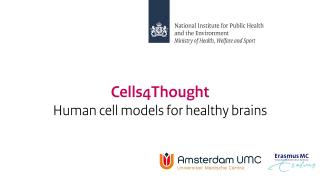
Projects and initiatives
HealthToxicologyInnovationIn vitro
Cells4Thought: using iPSCs for neurodevelopmental health
The prevalence of neurodevelopmental disorders (NDDs), including cognitive impairments, is increasing worldwide with great impact on daily life quality. There is evidence that exposure to chemicals may contribute to the incidence of NDD. However, a causal link is lacking. Towards this goal, a human-relevant in vitro model system mimicking parts of brain development, such as neuronal network functioning, could be used for mechanistic research on how gene-environment interactions contribute to the development of NDD. This is going to be studied in the project Cells4Thought, using induced pluripotent stem cells form different individuals to study the effect of chemicals on neuronal differentiation.

Projects and initiatives
HealthInnovationPolicy
We all want a safer world for humanity, animals and the environment: Transition Animal-free Innovation
Why is the transition to animal-free research so important? What are animal-free models? How does TPI (Transition Animal-Free Innovation) encourage their development and use? And who are we working with to make this happen? We explain this in our animation.
More and more animal-free tests and research methods are becoming available, but not all research questions or safety tests can be answered in this way yet. In addition, the validation, qualification and acceptance of non-animal innovations still lags behind. Therefore, the Dutch Ministry of Agriculture, Nature and Food Quality (LNV) stimulates the development and application of animal-free innovations. This is done with the partner programme Transition Animal-free Innovation (TPI).
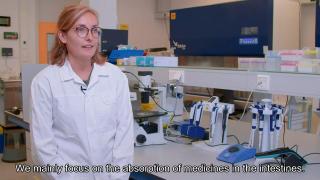
Projects and initiatives
HealthInnovationIn vitro
VitalTissue: scientific research can be more human(e)
The goal of VitalTissue is to facilitate the availability of vital human residual tissue for all researchers in the Netherlands. This video shows how VitalTissue works. From a request from a researcher, the donation of the residual tissue by the patient and the transport to the lab. This process is the result of a feasibility study conducted with many stakeholders. The national tissue bank ETB-BISLIFE will implement VitalTissue in practice.
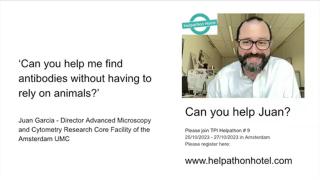
Meeting videos
HealthInnovationIn vitro
Helpathon #9 – Can you help Juan?
Juan is an experienced immunologist and scientific director of the cutting edge O2Flow facility for cytometry and cell sorting at the Amsterdam VU University Medical Center. Can you help Juan explore if and how he can transition his facility towards animal free antibodies?
Are you using antibodies in your research do you want others to help you find animal free alternatives for your specific research let us know. More information can be found [here] (https://www.helpathonhotel.org/coming-up).
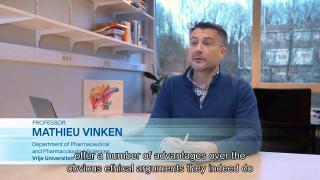
Innovation examples
HealthToxicologyInnovationIn vitro
Development of 3D liver spheroids
Human-based in vitro models are increasingly being used in the hepatology field. And in addition to the obvious ethical arguments, they offer several advantages over the classical animal models. One of them is the ability to perform mechanistic research at the molecular level in a well-controlled setting and reduce species differences. These liver-based in vitro models can range from simple monolayer cultures of hepatocytes to the liver-on-chips systems in which all liver cells are cultured in a 3D configuration on a microfluidic platform. Liver-based in vitro models must be selected on a case-by-case basis and should fit the purpose of the research, which might go from fundamental to translational research.
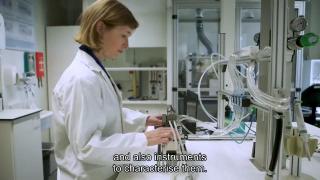
Innovation examples
HealthToxicologyInnovationIn vitro
Platform for in vitro airborne inhalation testing
The air-liquid interface (ALI) technique uses lung cells cultured on a tiny polymer membrane in a cup. On one side of the membrane is a liquid containing the medium necessary for the cells to survive, while the other side is in contact with air. This is similar to the situation in the human lung. The compound to be tested is administered via an aerosol, vapor, or gas to mimic the situation in human lungs. By monitoring different parameters in the cell model before and after the compound is added, it is possible to measure the effects on lung cells. Depending on the test to be carried out, the lung cells can come from different regions in the respiratory tract and even from a variety of people, including individuals who smoke a lot or have specific diseases such as chronic obstructive pulmonary disease or asthma.
In vitro ALI inhalation testing (https://doi.org/10.1021/acs.est.7b00493) adds value for e.g. pre-clinical trials and research in the pharmaceutical industry and testing (new) compounds for the chemical sector and beyond. The advantages of ALI inhalation testing are that it is a non-animal method, it reduces the use of in vivo experiments, pre-clinical testing with human-derived cell models is more realistic and limits clinical trial failures and it provides faster and more efficient testing of compound
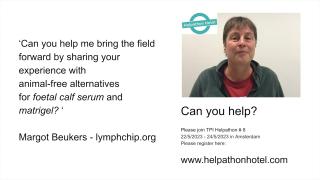
Meeting videos
HealthInnovationIn vitro
Helpathon #8 – Can you help Margot?
Margot Beukers is the LymphChip program manager. Can you help Margot bring the field forward by sharing your experience with animal-free alternatives for Foetal Calf Serum and Matrigel?
Click on the link in the video to sign up and read more information on this Helpathon on the website (https://www.helpathonhotel.org/coming-up).